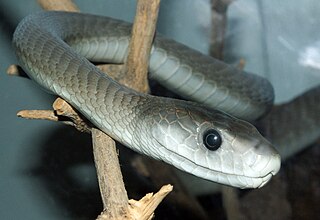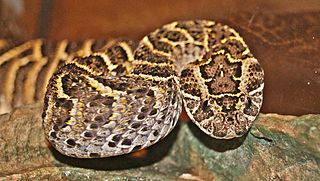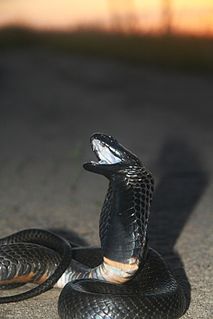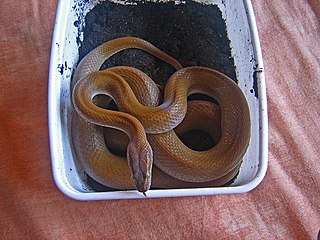François Marie Daudin was a French zoologist.

The black mamba is a species of highly venomous snake belonging to the family Elapidae. It is native to parts of sub-Saharan Africa. First formally described by Albert Günther in 1864, it is the second-longest venomous snake after the king cobra; mature specimens generally exceed 2 m and commonly grow to 3 m. Specimens of 4.3 to 4.5 m have been reported. Its skin colour varies from grey to dark brown. Juvenile black mambas tend to be paler than adults and darken with age.

The puff adder is a venomous viper species found in savannah and grasslands from Morocco and western Arabia throughout Africa except for the Sahara and rainforest regions. It is responsible for causing the most snakebite fatalities in Africa owing to various factors, such as its wide distribution, frequent occurrence in highly populated regions, and aggressive disposition. Two subspecies are currently recognized, including the nominate subspecies described here.

Nature's Valley is a holiday resort and small village on the Garden Route along the southern Cape coast of South Africa. Nature's Valley lies between the Salt River, the foothills of the Tsitsikamma Mountains, the Indian Ocean and the Groot River lagoon. Nature's Valley has a balmy climate and is surrounded by the de Vasselot Nature Reserve which is part of the Tsitsikamma Park, and in turn part of the Garden Route National Park.

Lycophidion is a genus of nonvenomous lamprophiid snakes commonly referred to as the wolf snakes.

The Cape wolf snake is a species of oviparous, nonvenomous snake which occurs over a wide area of Southern, Central, and East Africa. Though docile and harmless, it may be confused with the very venomous stiletto snake.

The black-necked spitting cobra is a species of spitting cobra found mostly in sub-Saharan Africa. They are moderately sized snakes that can grow to a length of 1.2 to 2.2 m in length. Their coloration and markings can vary considerably. They prey primarily on small rodents. They possess medically significant venom, although the mortality rate for untreated bites on humans is relatively low. Like other spitting cobras, they can eject venom from their fangs when threatened. The neurotoxic venom irritates the skin, causing blisters and inflammation, and can cause permanent blindness if the venom makes contact with the eyes and is not washed off.

Boodontinae is a subfamily of colubrid snakes.

The forest cobra, also commonly called the black cobra and the black and white-lipped cobra, is a species of venomous snake in the family Elapidae. The species is native to Africa, mostly the central and western parts of the continent. It is the largest true cobra species with a record length of 3.2 metres. Although it prefers lowland forest and moist savanna habitats, this cobra is highly adaptable and can be found in drier climates within its geographical range. It is a very capable swimmer and is often considered to be semi-aquatic. The forest cobra is a generalist in its feeding habits, having a highly varied diet: anything from large insects to small mammals and other reptiles. This species is alert, nervous and is considered to be a very dangerous snake. When cornered or molested, it will assume the typical cobra warning posture by raising its fore body off the ground, spreading a narrow hood, and hissing loudly. Bites to humans are less common than from other African cobras due to various factors, though a bite from this species is a life-threatening emergency.

The Lamprophiidae are a family of snakes found mostly in Africa, but also in parts of southern Europe and western Asia. A few species reach southeastern Asia. There are 322 species as of April 2019.

Chirindia is a genus of amphisbaenians in the family Amphisbaenidae. Commonly known as pink round-headed worm lizards, species in the genus Chirindia are native to East Africa and southern Africa, from Tanzania to South Africa. They are unpigmented worm lizards with rounded heads, and extensive fusion of the head shields.

Lycophidion variegatum, also known as the variegated wolf snake, is a species of small nocturnal snake in the family Lamprophiidae. The species actively hunts lizards in small crevices, and is endemic to southern Africa.

The African golden wolf or African wolf is a canine native to North Africa, West Africa, the Sahel, northern East Africa, and the Horn of Africa. It is the descendant of a genetically admixed canid of 72% gray wolf and 28% Ethiopian wolf ancestry. It is listed as least concern on the IUCN Red List. In the Atlas Mountains, it was sighted in elevations as high as 1,800 m (5,900 ft). It is primarily a predator, targeting invertebrates and mammals as large as gazelle fawns, though larger animals are sometimes taken. Its diet also includes animal carcasses, human refuse, and fruit. The African golden wolf is a monogamous and territorial species; offspring remain with the family to assist in raising their parents' younger pups.

Lamprophiinae is a subfamily of lamprophiid snakes, a large group of mostly African snakes most of which were formerly classified as colubrids but which we now know are actually more closely related to elapids.












